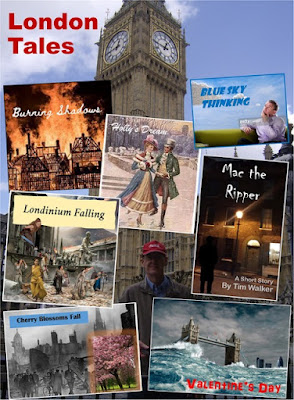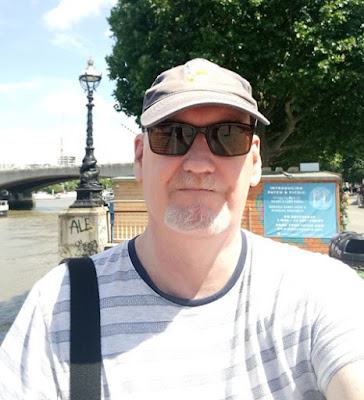 |
| Welcome to my Blog! Wander through worlds real and fictional, meet interesting people, visit exciting places and find good books to enjoy along the way! |
Burning Shadows
An explosion coming from the river caused gasps and glances in that direction. “A warehouse has exploded!” a man next to them exclaimed. “’Tis the Dutch - they are storing gunpowder in our city to attack us!” another shouted.
The sound urged the harried Londoners to redouble their efforts to escape the pall of black smoke rising from the glowing inferno barely three streets behind them. The fire was spreading quickly in a pernicious, swirling wind.
Reverend Swallow had removed the tall, black hat that marked him out as a Puritan to wipe the sweat from his brow. “’Tis the end of days as told in the Book of Revelation, in this cursed year bearing the number of the beast, 666.”
The stern expressions around him showed this was of little comfort to his group of family and fellow believers. Any further revelations were halted by the splintering of wood accompanied by the groan of collapsing buildings as the insatiable fire ate up the flimsy houses in its path. They felt a rush of hot air on their necks as they picked up their carts and guided them down Ludgate Hill towards the Ludgate - the most westerly gate out of the old medieval walled city.
“We must look for my father amongst the crowd,” Goody Swallow shouted above the noise of braying donkeys, honking geese, clucking hens, and the fretful utterances of the fleeing tide of humanity, most of whom had given up their homes and possessions to the greedy flames. A dog snapped at Ruth who cried out in fear, causing her mother to beat the dog away with her staff. The crowd was bunching together as they approached the entrance to the stone gatehouse that was their route to safety.
“Over here!” William Say’s firm, commanding voice floated out of the gloom of the gatehouse passage. The Swallows angled their carts towards the damp, brick wall of the ancient archway where William was waiting. He hugged his daughter and granddaughter. “I am much cheered on this miserable day to greet you all,” he muttered, shaking his son-in-law’s hand.
“Thank the Lord you’re safe, William,” Reverend Swallow said, reluctant to let go of his hand.
“And thanks to little Ruthie for finding me and warning me off from returning to your house.” He pinched the gleeful girl’s cheek.
“Aye, but the sheriff’s dogs will no doubt be on our trail. Come, let us hurry to my meeting house beyond the Strand.” They rejoined the throng moving west, crossing a bridge over the River Fleet that joined the Thames just a hundred yards to their left, then uphill along Fleet Street.
Authors Note:
The Great Fire of London started in Thomas Farriner’s bakery on Pudding Lane on the night of 1st September 1666. It was speculated, in a television documentary, that the cause may have been that the oven door was left open and a spark jumped out to ignite a reed mat. The wind direction at the time was east to west, and the dry conditions allied with closely grouped and combustible houses, ensured the fire spread quickly. King Charles II didn’t flee London from the encroaching fire, as William Say suggests in the story. Perhaps on the advice of courtiers, the king and his brother, the Duke of York, took the opportunity to salvage their tarnished reputations by remaining to organise firefighters and the deployment of the cavalry to pull down houses to make fire breaks. Their efforts, perhaps aided by a dying wind, succeeded in stopping the fire’s spread and, on the fourth day, the Great Fire burnt out. The damage caused by the Great Fire was immense: 436 acres of London were destroyed, including 13,200 houses and 87 out of 109 churches. An accurate death toll was not recorded – the official figure was a mere six deaths.
Lawyer and Member of Parliament, William Say, was one of 59 signatories to King Charles I’s execution order in 1649, and is thought to have drafted the document. He was never captured, and an entry in Wikipedia tells us he is thought to have died in 1666, but where and of what cause, remains unknown. An entry in the biography of William Say on the British Civil Wars website tells us: “He joined [General] Ludlow at Vevey in Switzerland until 1664 and is believed to have been involved in plots against the government of England in 1665-6. He probably died in the Netherlands around 1666.” (www.bcw-project.org).
Many Regicides were buried in unmarked graves for fear their remains would be exhumed by vengeful Royalists (as were the bodies of Cromwell and Ireton) and their skulls displayed on spikes as traitors. The only other historical figure in the story, apart from Say, is Sheriff of London, Sir William Hooker. It is not known if William Say returned to England during his exile – I picked him for my story because of uncertainty over his fate and the suggestion he lived until 1666.
Buy Link
about the author
follow the tour
You might also like
books written by Helen Hollick
Website: https://helenhollick.net/
Amazon Author Page: https://viewauthor.at/HelenHollick
 |
THE PENDRAGON's BANNER TRILOGY New Editions available worldwide (except USA/Canada) |
 |
Available USA/Canada |
 |
| Have you ever thought of saying 'thank you'? saying thank you |











Thanks so much for hosting Tim Walker on your fabulous blog today, Helen.
ReplyDeleteTake care,
Cathie xx
The Coffee Pot Book Club